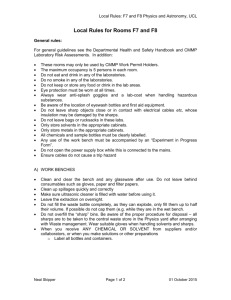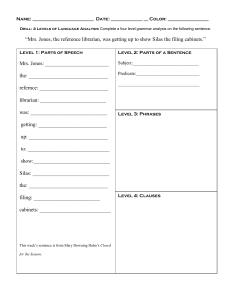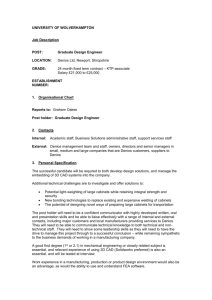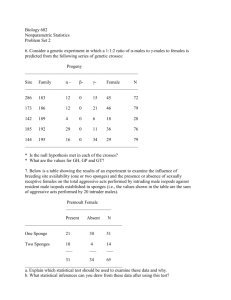Teaching upgrades for BioSciences Rooms 3521, 3523, and 3513
advertisement
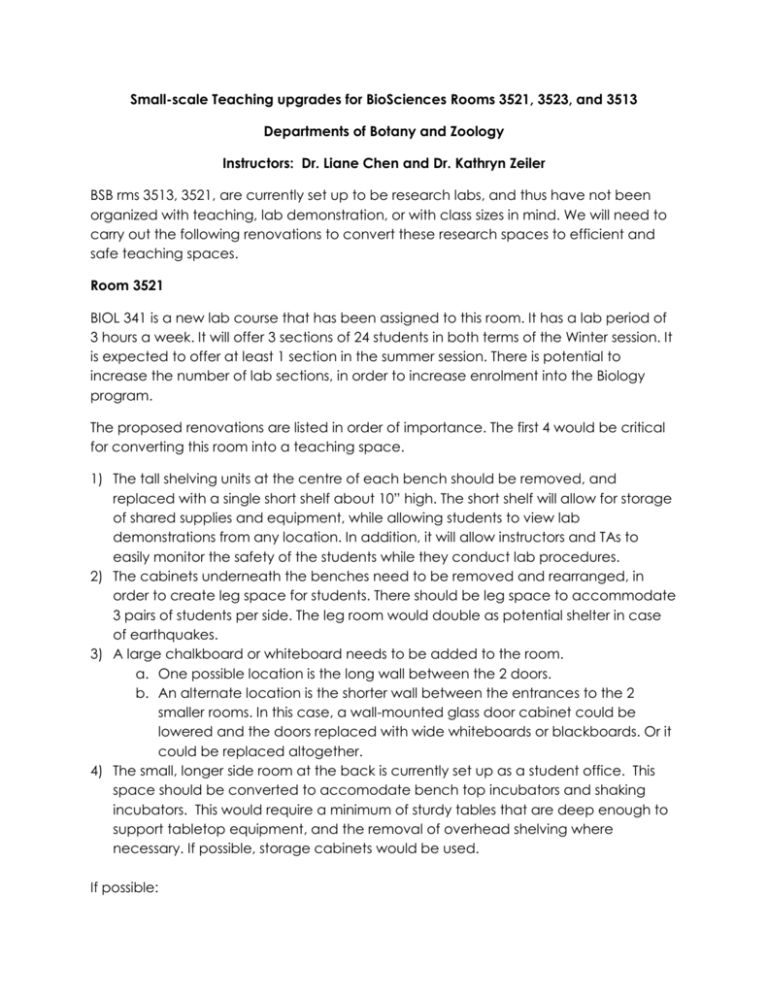
Small-scale Teaching upgrades for BioSciences Rooms 3521, 3523, and 3513 Departments of Botany and Zoology Instructors: Dr. Liane Chen and Dr. Kathryn Zeiler BSB rms 3513, 3521, are currently set up to be research labs, and thus have not been organized with teaching, lab demonstration, or with class sizes in mind. We will need to carry out the following renovations to convert these research spaces to efficient and safe teaching spaces. Room 3521 BIOL 341 is a new lab course that has been assigned to this room. It has a lab period of 3 hours a week. It will offer 3 sections of 24 students in both terms of the Winter session. It is expected to offer at least 1 section in the summer session. There is potential to increase the number of lab sections, in order to increase enrolment into the Biology program. The proposed renovations are listed in order of importance. The first 4 would be critical for converting this room into a teaching space. 1) The tall shelving units at the centre of each bench should be removed, and replaced with a single short shelf about 10” high. The short shelf will allow for storage of shared supplies and equipment, while allowing students to view lab demonstrations from any location. In addition, it will allow instructors and TAs to easily monitor the safety of the students while they conduct lab procedures. 2) The cabinets underneath the benches need to be removed and rearranged, in order to create leg space for students. There should be leg space to accommodate 3 pairs of students per side. The leg room would double as potential shelter in case of earthquakes. 3) A large chalkboard or whiteboard needs to be added to the room. a. One possible location is the long wall between the 2 doors. b. An alternate location is the shorter wall between the entrances to the 2 smaller rooms. In this case, a wall-mounted glass door cabinet could be lowered and the doors replaced with wide whiteboards or blackboards. Or it could be replaced altogether. 4) The small, longer side room at the back is currently set up as a student office. This space should be converted to accomodate bench top incubators and shaking incubators. This would require a minimum of sturdy tables that are deep enough to support tabletop equipment, and the removal of overhead shelving where necessary. If possible, storage cabinets would be used. If possible: 5) Electrical outlets might need to be adapted for some of the equipment. Some of the outlets are already present, but we won’t know our exact needs until we move into the space. 6) Deep clean the lab, clean and wax the floor, patch up all holes, and if necessary, apply a fresh paint of coat to bench tops, cabinets, and walls. If a room is clean and well organized, students will work harder to keep it this way. But students won’t take as much care with a room that is already scarred and scratched up. 7) A pull-down screen should be mounted so that it can be pulled down in front of the whiteboard. This will allow for the use of a computer plus projector, which is required to demonstrate the use of bioinformatics databases and tools that are available online. This would also accommodate future teaching needs. 8) Remove gas/air lines on the wall by the front door, to allow equipment or cabinets to be placed directly against the wall (this was the hookup for a biological safety cabinet). 9) Extra shelving outside the door to hold open food and drinks, so that students can leave their food outside the lab. Room 3523 BIOL 340 is a new lab course that has been assigned to this room. It has a lab period of 3 hours a week. It will offer 3 sections of 24 students in both terms of the Winter session. It is expected to offer at least 1 section in the summer session. There is potential to increase the number of lab sections, in order to increase enrolment into the Biology program. The proposed renovations are listed in order of importance. The first 4 would be critical for converting this room into a teaching space. 1) The tall shelving units at the centre of each bench should be removed, and replaced with a single short shelf about 10” high. The short shelf will allow for storage of shared supplies and equipment, while allowing students to view lab demonstrations from any location. In addition, it will allow instructors and TAs to easily monitor the safety of the students while they conduct lab procedures. 2) The cabinets underneath the benches need to be rearranged, in order to create leg space for students. There should be leg space to accommodate 3 pairs of students per side. The leg room would double as potential shelter in case of earthquakes. 3) A large chalkboard or whiteboard needs to be added to the room. a. One possible location is the long wall between the 2 doors. The distance between this wall and the adjacent bench is too narrow to allow for a wallmounted cabinet, so the board will have to be mounted directly on the wall. b. An alternate location is the shorter wall opposite the entrances to the 2 smaller rooms. Benches and overhead cabinets would have to be moved to make space for it. 4) The small windowless room may need adjustments to the existing desks, in order to accommodate 4 fluorescence microscopes. If possible: 5) A separate cabinet for 24 microscopes would need to be constructed for the room. 6) Deep clean the lab, clean and wax the floor, patch up all holes, and if necessary, apply a fresh paint of coat to bench tops, cabinets, and walls. If a room is clean and well organized, students will work harder to keep it this way. But students won’t take as much care with a room that is already scarred and scratched up. 7) Extra shelving outside the door to hold open food and drinks, so that students can leave their food outside the lab. 8) A pull-down screen should be mounted so that it can be pulled down in front of the whiteboard. This will allow for the use of a computer plus projector, which should help us accommodate future teaching needs. Room 3513 This room is to become a prep room supporting a number of senior lab courses in each term (BIOL 340, BIOL 341, BIOL 337, BIOL 351, BIOL 352), and will house at least 3 technicians. While it is generally well set up, the following renovations would meet anticipated needs and address physical health. Renovations are listed in order of priority. The first 3 would be the most critical for the use of this space. 1) Elevate the larger, double sink at the back corner, so that staff do not have to hunch over to use it. 2) Install a dishwasher that is rated for labware. We need a dishwasher in order to handle the cleaning for at least 3 multi-section courses per term. This should NOT be a dishwasher for home use, as our glassware can require harsher cleaning agents that could destroy the components of a regular dishwasher. This should be installed by the larger double sink. The counter and floor cabinets may need to be adjusted to accommodate the dishwasher. 3) Rearrange bench cabinets along the wall with the double sink, to create leg space associated with two benchtop laminar flow hoods. If possible: 4) Install soundproofing panels around noisy equipment, in order to protect hearing. (One of our technicians already suffers from tinnitus, and humming, buzzing equipment exacerbates it.) 5) Deep clean the lab, clean and wax the floor, patch up all holes, and if necessary, apply a fresh paint of coat to bench tops, cabinets, and walls.
